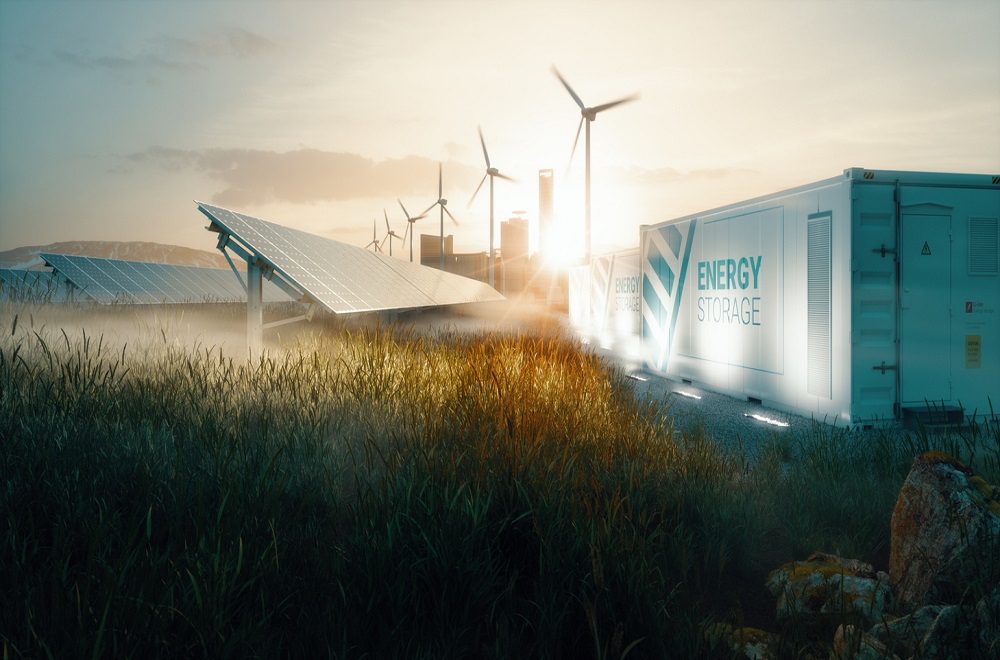Efforts to limit rising temperatures by controlling greenhouse gasses (GHG) are in aggressive mode globally. As the pace of decarbonization accelerates, the future grid will depend more heavily on wind and solar power.
Today's wind turbines and solar panels are much more efficient and economically viable than ever before. However, adding a greater share of renewables to the power mix comes with its own challenges. Wind and solar are inherently intermittent and variable. They only produce when the wind is blowing or the sun is shining, and therefore require complementary technologies to ensure that the balance between supply and demand is always maintained.
Energy storage systems (ESS) help mitigate these issues by storing enough electricity during low demand and high production to fill the gaps when the output from wind turbines and solar panels drops. They offer many other benefits to the grid as well.
Shifting away from centralized thermal power plants, as the main providers of electricity, to distributed energy resources (DERs) or mixing them makes power systems more complex. The grid requires flexibility to keep the power system stable during short-term disturbances, meet peak capacity requirements, and ramp up and down in response to supply and demand fluctuations. Stringent decarbonization objectives limit the use of traditional flexibility providers—mainly thermal power plants. Batteries and other ESS can help supply these services.
Most of the ESS utilized today are what's known as shorter duration storage. They can store enough energy for at least four hours of continuous support—perhaps a bit more. Longer duration storage technologies are needed as more renewables are deployed on the grid.
Long duration energy storage (LDES) can be one of the key solutions to the intermittent nature of renewable resources.
LDES (Un)Defined
It is broadly accepted that LDES is a storage system that can discharge for 10 hours or more at their rated power.
However, there is as yet no definitive definition of LDES by a standards organization such as the International Organization for Standardization (ISO) or Institute of Electrical and Electronics Engineers (IEEE). In one of their Storage Futures Studies (SFS), the National Renewable Energy Laboratory (NREL) stated, "Because of the different motivations and practices for how long-duration storage is discussed and analyzed, we do not recommend that a single definition for long-duration storage be used."
According to Sandia National Laboratories January 2021 ISSUE BRIEF on LDES, "The lack of consensus on an LDES definition results from a lack of agreement on what LDES technologies would, could, or should be required to do, which in turn results from the absence of a well-established marketplace in which LDES actively participates."
LDES is being considered to address critical industry needs for meeting demand and operating the grid. One such need is the desire for LDES resources to provide hours, days or even weeks of discharging duration to aid renewable integration, provide backup power and resiliency, and defer transmission development substantially. Unfortunately, beyond that, there is no widely accepted definition of LDES.
As the term is used today in the industry, LDES could potentially cover a range from 6 to 1,000+ hours of discharge capability.
LDES Future Trends
While there is not yet a standards-based definition of LDES, leading experts agree on its importance in enabling the utilization of renewables by energy providers, utilities and large C&I end users.
The LDES Council, a CEO-led global organization, was launched at the United Nations Climate Change Conference (COP26) with the intent to accelerate energy decarbonization by driving innovation and deployment of LDES. The U.S. Department of Energy's (DOE) Energy Earthshots Initiative aims to reduce the cost of grid-scale energy storage by 90% for systems that deliver 10+ hours of duration within the decade.
The energy storage innovation ecosystem is supported by governments globally. The U.S. government is funding and encouraging universities, national laboratories and R&D programs through the ARPA-E and DOE loan program. These efforts have resulted in advanced lithium or solid state technology startups like Sila Nanotechnologies, Solid Power, SES, Sion Power, Ionic Materials, Enovix, QuantumScape, as well as some leaders in other technologies such as Natron Energy and Form Energy.
Energy consultancy Wood Mackenzie forecasts that energy storage will greatly increase after the worst of the pandemic passes. Le Xu, Senior Analyst, Power and Renewables, states: "With the market recovering following the pandemic and a growing acceptance of energy storage as a mainstream power technology, the total energy storage market will double in size in 2021 to reach 56 GWh, with that number expected to increase by 17x in 2030."
Utility-scale batteries are expected to account for most of the storage growth worldwide. According to The International Energy Agency (IEA), the installed capacity is expected to increase sixfold over 2021-2026, driven by incentives and an increasing need for system flexibility, especially where the share of variable renewable energy (VRE) covers almost all demand in certain hours of the day.
As per an August 2021 report by the U.S. Energy Information Administration (EIA), electric power markets in the U.S. are undergoing significant structural changes that will result in the installation of the ability of large-scale battery storage to contribute 10,000 megawatts to the grid between 2021 and 2023—10 times the capacity in 2019.
Not only is the amount of large-scale battery storage changing, so too is how it's deployed. Most large-scale battery energy storage systems (BESS) deployed in the U.S. in the next three years are expected to be built at power plants that produce solar PV energy. This is a change from recent years, in which most large-scale BESS were built as standalones. According to the EIA report, if all currently announced projects from 2021 to 2023 become operational, the share of U.S. battery storage that is co-located with generation would increase from 30% to 60%.
Nor-Cal can help you navigate the changing landscape of renewable energy.
At Nor-Cal, we believe energy storage has the potential to accelerate the full decarbonization of the electric grid. We are well-positioned to handle SCADA and PPC requirements for PV solar projects and Energy Management Systems (EMS) for projects that include BESS. Our engineering team can meet all the control mode requirements specific to the project. We work with our customers to customize our control system to facilitate optimization of BESS services while ensuring ITC compliances.
Whether you need a PV + Storage integration or a standalone BESS, we'd be happy to talk with you about your options. Schedule a call with us today.





